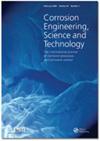Crevice corrosion behaviour and mechanism of laser additive manufacturing nickel-based alloy by using wire beam electrode
IF 1.5
4区 材料科学
Q4 MATERIALS SCIENCE, MULTIDISCIPLINARY
Corrosion Engineering, Science and Technology
Pub Date : 2023-04-11
DOI:10.1080/1478422X.2023.2197334
引用次数: 1
Abstract
ABSTRACT The wire beam electrode (WBE) of laser additive manufacturing (LAM) nickel-based alloy was prepared to help study its crevice behaviour and mechanism at different area in the crevice with different size. The results show that the LAM nickel-based alloy with the crevice size of 0.1 and 0.3 mm presents crevice corrosion characteristics at 1 day and 3 days due to the formation of oxygen-concentration cell at the former two cases caused by the difficult migration of oxygen from the outside into the crevice. The corrosion at the middle and inside of the crevice is more serious than the outside, which is reflected by the 29.92% lower contents of O2− at the inside than that at the outside of the crevice. Locally, inter-phase corrosion appears between the uniform nickel-based alloy matrix and the insoluble oxides at the inside of the crevice.线束电极激光增材镍基合金缝隙腐蚀行为及机理
摘要制备了激光增材制造(LAM)镍基合金的线束电极(WBE),以研究其在不同尺寸缝隙中不同区域的缝隙行为和机理。结果表明,缝隙尺寸分别为0.1和0.3的LAM镍基合金 mm在第1天和第3天表现出缝隙腐蚀特征,这是由于在前两种情况下氧气难以从外部迁移到缝隙中而形成氧气浓缩池。缝隙中部和内部的腐蚀比外部更严重,这反映在缝隙内部的O2−含量比缝隙外部低29.92%。局部而言,均匀的镍基合金基体和缝隙内部的不溶性氧化物之间出现相间腐蚀。
本文章由计算机程序翻译,如有差异,请以英文原文为准。
求助全文
约1分钟内获得全文
求助全文
来源期刊

Corrosion Engineering, Science and Technology
工程技术-材料科学:综合
CiteScore
3.20
自引率
5.60%
发文量
58
审稿时长
3.4 months
期刊介绍:
Corrosion Engineering, Science and Technology provides broad international coverage of research and practice in corrosion processes and corrosion control. Peer-reviewed contributions address all aspects of corrosion engineering and corrosion science; there is strong emphasis on effective design and materials selection to combat corrosion and the journal carries failure case studies to further knowledge in these areas.
 求助内容:
求助内容: 应助结果提醒方式:
应助结果提醒方式:


